This is true of all temples in South Korea, but Wawujeongsa Temple means 'Wowjeong Temple' in English.
First,
the "Wawu (臥牛, 와우)" in "Waujeongsa" means "lying cow" and refers to Buddha, who attained nirvana. In addition, the temple's location resembles the shape of a reclining cow and is said to be derived from the Buddha's original name, Gotama (meaning "cow") Siddhartha.
[와우정사의 '와우(臥牛)'는 '누워 있는 소'라는 뜻으로 열반에 든 부처님을 가리킵니다. 또한 사원의 위치가 누워있는 소의 형상을 닮아 부처님의 원래 이름인 고타마('소'라는 뜻) 싯다르타에서 유래했다고 합니다.]
The word "Jeong (精, 정)" refers to the energy that is the source of all things in the heavens and earth.
['정(精)'은 천지 만물의 근원이 되는 기운을 뜻합니다.]
"Sa (舍, 사)" means temple.
['사(舍)'는 사원을 의미합니다.]
In other words, "Wa-wu-jeong Temple (臥牛精舍, 와우정사)" means the temple where the Buddha lay. So it's Wa-wu-jeong-sa, not Wawujeongsa Temple.
[즉, '와우정사(臥牛精舍)'는 부처님이 누워 계시는 절이라는 뜻입니다.]
Wawujeongsa is the general headquarters of the Korean Buddhist sect of Yeolbansang in Hagok-dong, Chaein-gu, Yongin, Gyeonggi-do, South Korea.
Waujeongsa Temple was founded in 1970 by Haeam Haegok Samjang, a Buddhist monk, as the headquarters of the Nirvana sect of Korean Buddhism, to recreate the spirit of the Three Kingdoms era of patriotic Buddhism for the sake of peaceful reunification of North and South Korea and world peace.
[와우정사는 경기도 용인시 처인구 하곡동에 있는 대한불교 열반종의 총본산입니다. 와우정사는 1970년 해암 해곡스님이 남북한의 평화통일과 세계 평화를 위해 호국불교의 삼국시대 정신을 재현하고자 대한불교 열반종 총본산으로 창건한 사찰로, 대한불교조계종 총무원장 해암 해곡스님이 창건했습니다.]
Waujeongsa is home to a reclining Buddha statue made of incense wood from India, which is recognized by the Guinness Book of World Records as the world's largest wooden Buddha statue.
The temple also has a five-headed Buddha statue made of eighty thousand brass rods that took ten years to make, a golden bell named the Bell of Unification and rung at the 1988 Olympic Games, a statue of Buddha's asceticism, a statue of Maitreya, an 11-meter statue of Buddha (three meters of the head and eight meters of the upper body), and a pagoda made of stones from all over Korea and the world.
[와우정사에는 세계에서 가장 큰 목조 불상으로 기네스북에 등재된 인도산 향나무로 만든 누워 있는 불상이 있습니다.
이 외에도 10년의 제작 기간을 거쳐 8만 개의 놋쇠 막대로 만든 오두막 불상, 1988년 올림픽에서 '통일의 종'으로 불리며 울린 황금종, 부처님의 고행상, 미륵상, 11미터(머리 3미터, 상반신 8미터)의 불상, 한국과 세계 각지의 돌로 만든 탑 등 다양한 볼거리가 있습니다.]
In recent years, many Buddhist statues from around the world have been collected for the construction of the World Hall of Ten Thousand Buddhas, so you can see Buddhist statues from many countries. The temple also houses the full body of Shakyamuni Buddha from India, Sri Lanka, and Myanmar, as well as Pali and Sanskrit texts, the earliest scriptures of Buddhism. The temple is now well known abroad and is visited by monks and devotees as well as tourists.
[최근에는 세계 만불전 건립을 위해 세계 각국의 불상을 많이 수집하고 있어 여러 나라의 불상을 볼 수 있습니다. 이 사원에는 인도, 스리랑카, 미얀마에서 온 석가모니 부처의 전신과 불교의 초기 경전인 팔리어와 산스크리트어 경전도 소장되어 있습니다. 이 사원은 현재 해외에서도 잘 알려져 있으며 승려와 신도뿐만 아니라 관광객도 많이 방문합니다.]
Surprisingly, there is very little written about this temple in English, so I translated the Korean documentation into English.
So you may notice that this temple is a bit different from the ones you usually see in South Korea.
Let's take a look around the temple.
[그래서 이 사원은 한국에서 흔히 볼 수 있는 사원과는 조금 다르다는 것을 알 수 있습니다. 그럼 사원을 둘러보겠습니다.]

[와우정사의 상징인 부처님의 머리입니다.]

[이 석탑들은 백두산, 히말라야 등 불교 성지와 독일 베를린 장벽의 돌을 비롯해 세계 각지의 돌을 모아
한국의 통일을 염원하며 세워졌습니다.]


[포대화상]
http://en.wikipedia.org/wiki/Budai
Budai - Wikipedia
From Wikipedia, the free encyclopedia Figure in Buddhist and East Asian religious traditions Not to be confused with Buddha. Budai (Chinese: 布袋; pinyin: Bùdài; Korean: 포대, romanized: Podae; Japanese: 布袋, romanized: Hotei; Vietnamese: Bố
en.wikipedia.org
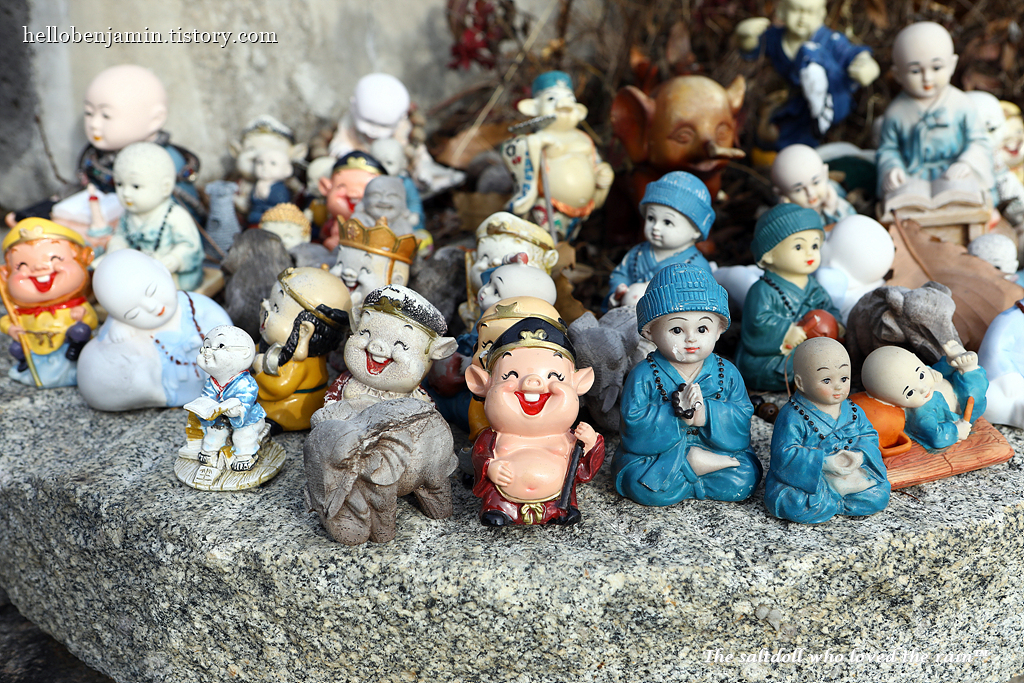
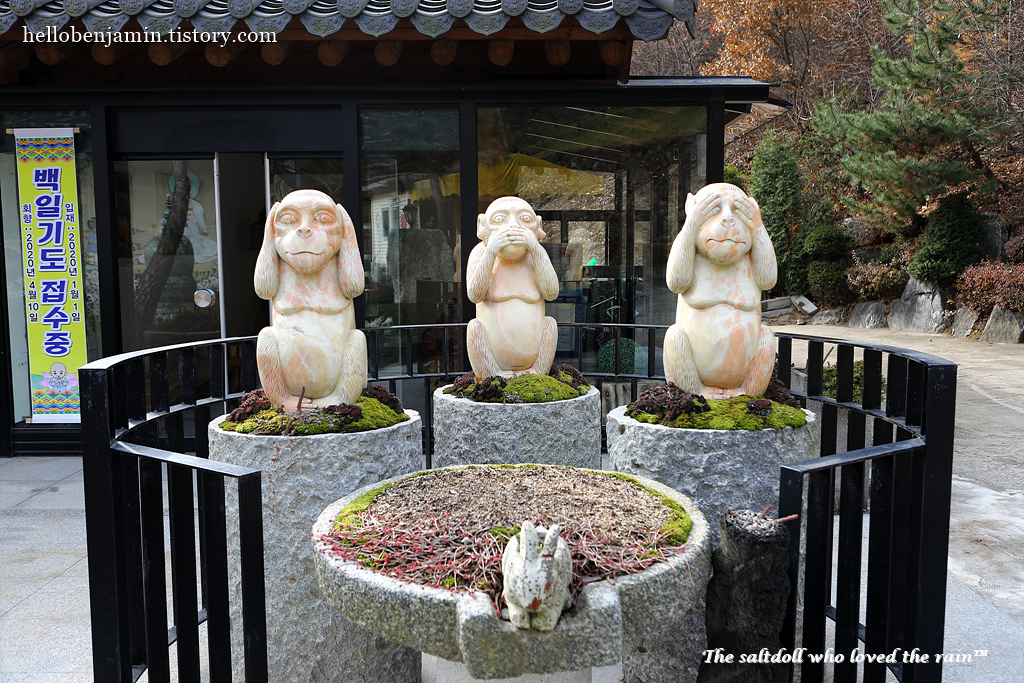
[삼불원]
The "Sambulwon" is a sculpture that means don't speak bad words, don't see bad things, and don't hear bad sounds.
['삼불원'은 나쁜 말을 하지 말고, 나쁜 것을 보지 말고, 나쁜 소리를 듣지 말라는 의미의 조형물입니다.]



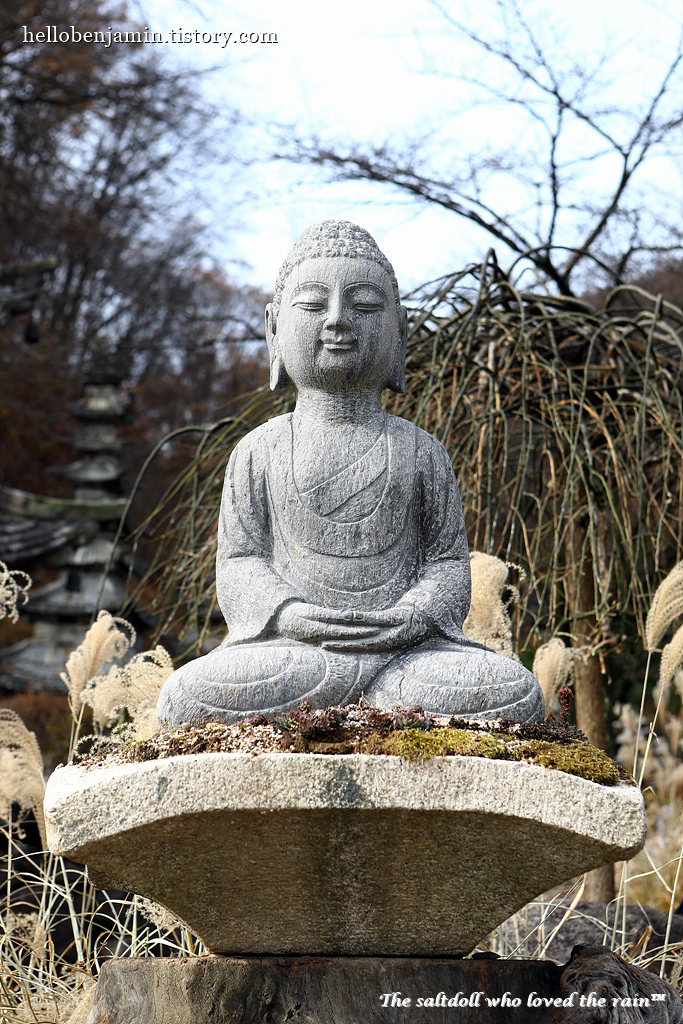
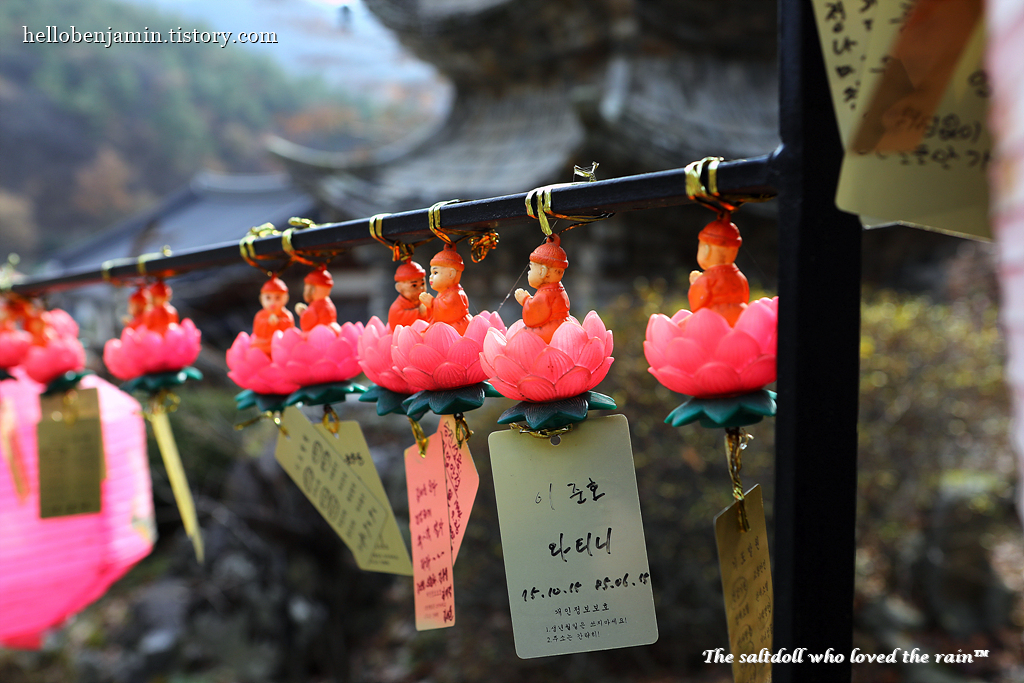

[이 석탑들은 한국의 통일을 염원하며 백두산과 히말라야 등 불교 성지에서 가져온 돌로 쌓은 탑입니다.]

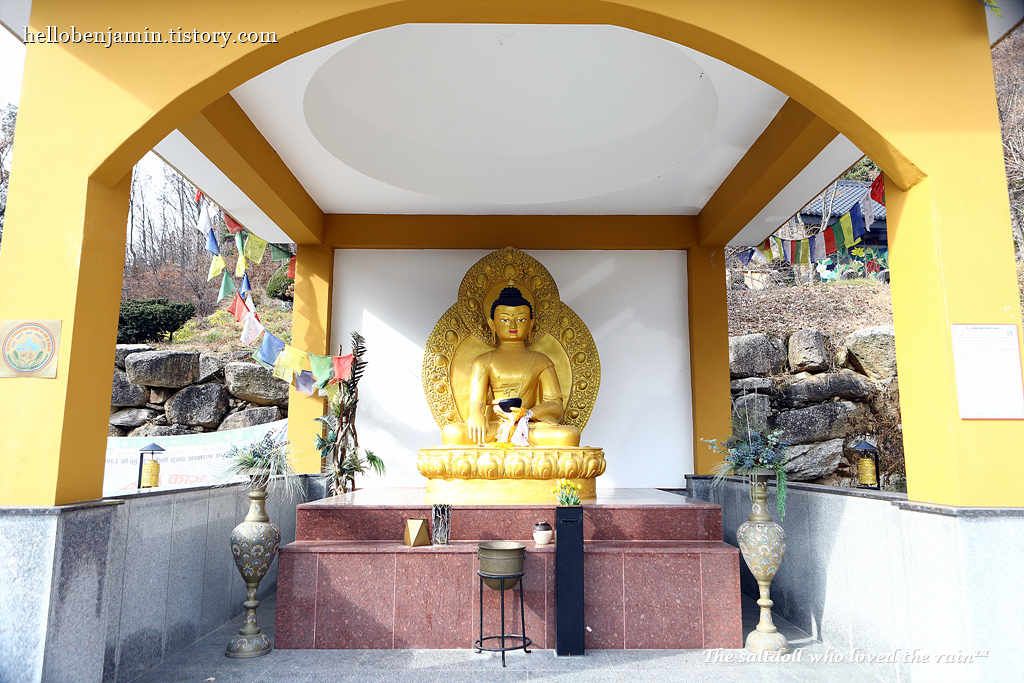

[금강역사]
https://en.wikipedia.org/wiki/Nio_(Buddhism)
Nio (Buddhism) - Wikipedia
From Wikipedia, the free encyclopedia Guardians of the Buddha This article is about Buddhist manifestations. For the video game, see Nioh. For the car company, see Nio Inc. For other uses, see NIO. Not to be confused with Neo. Niō (仁王) are two wrathfu
en.wikipedia.org


[인도네시아산 삼나무를 통째로 깎아 만든 길이 12미터의 불상으로, 세계에서 가장 큰 목조 불상으로
기네스북에 등재되어 있습니다.]


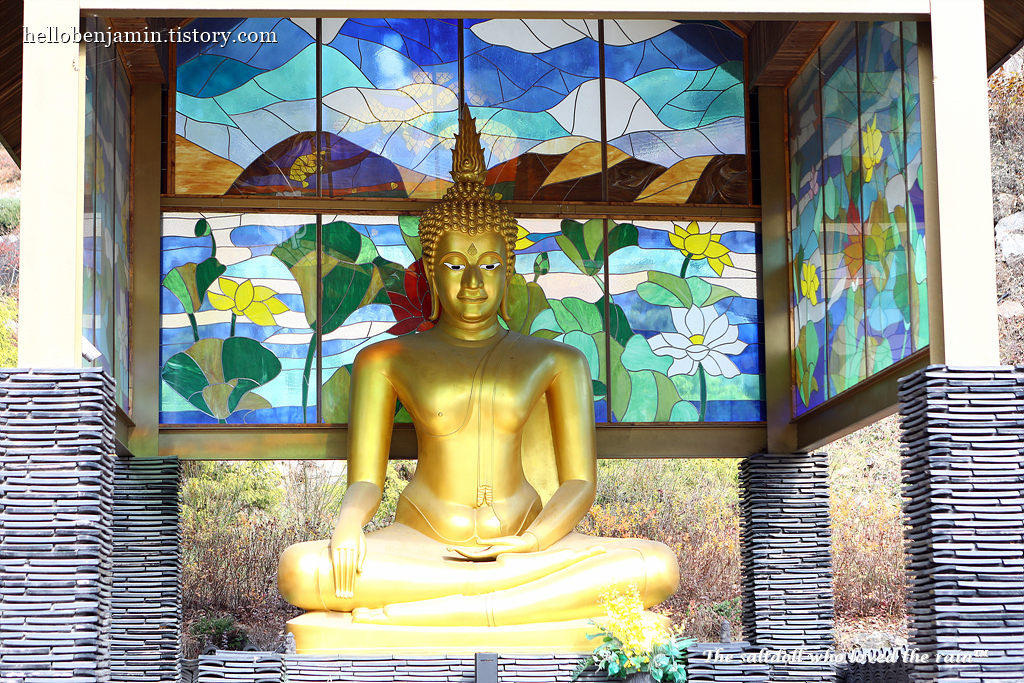
[한국전쟁에서 전사한 태국 군인들을 기리기 위해 세워진 태국풍의 불상입니다.]
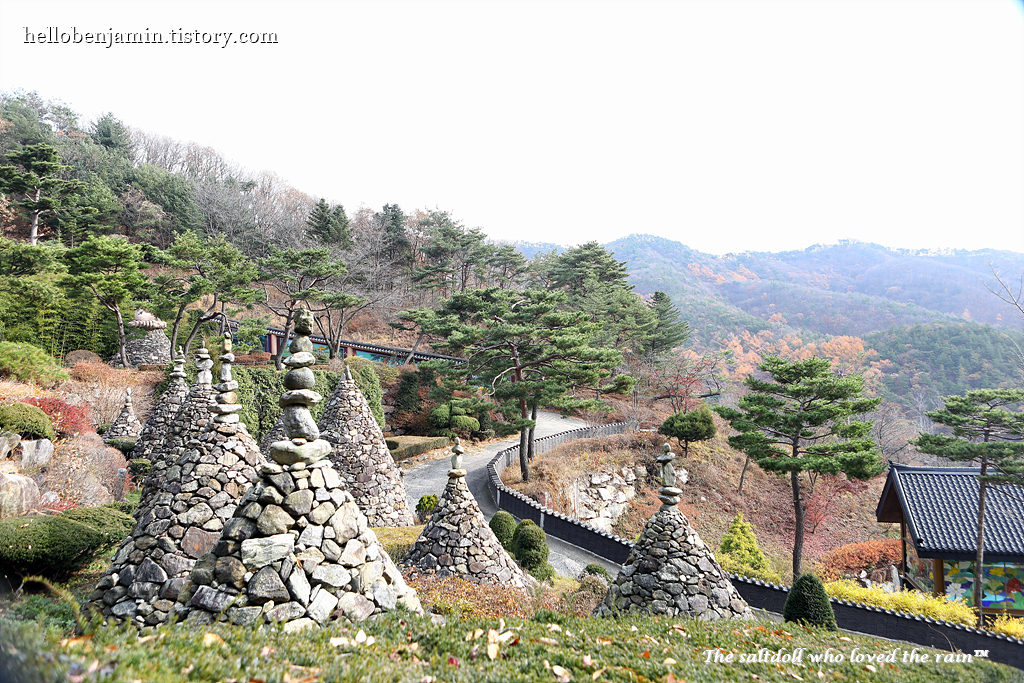
[도시 곳곳에 세워진 석탑은 한국의 통일을 상징하는 의미를 담고 있습니다.]

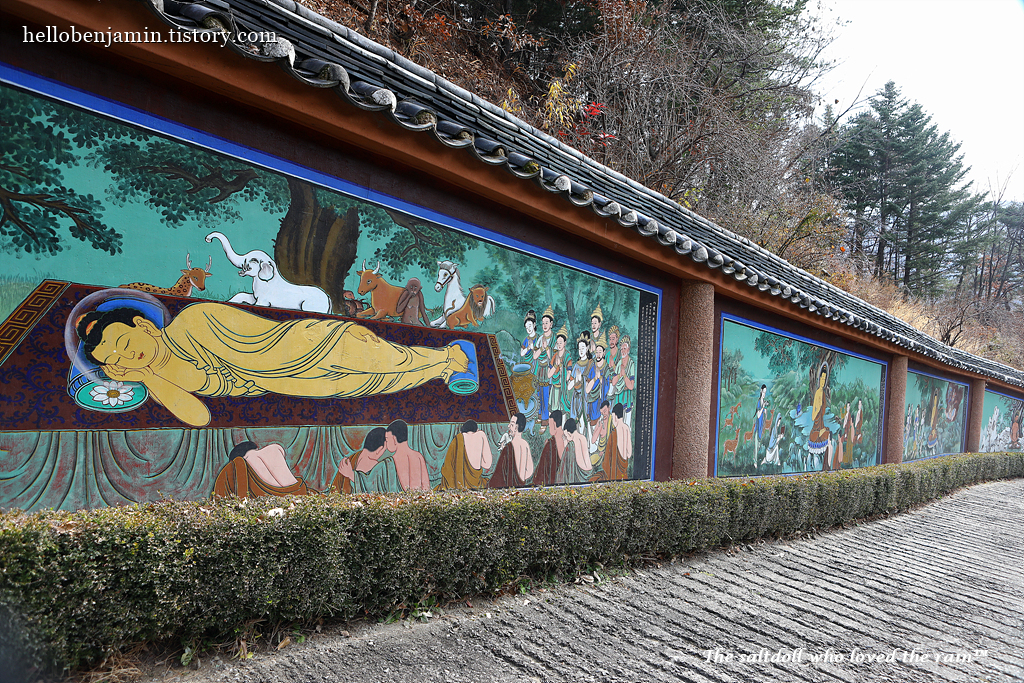
[이 벽화에는 부처님의 생애가 그려져 있습니다.]

[오백나한]
The 'Five Hundred Nahansang (O-baeg-na-han-sang)' is a painting or sculpture that depicts 500 Buddhist ascetics who have attained enlightenment and achieved the "Alahangwa (state of full attainment of arhatship)". In Korea, it was mainly created and worshipped during the Goryeo Dynasty.
Nahan would be the Christian equivalent of a "saint" of sorts. In other words, Nahansang are paintings or sculptures of enlightened monks.
['오백나한상(五百羅漢像)'은 깨달음을 얻어 '알라행과(아라한을 완전히 성취한 상태)'를 이룬 500명의 불교 수행자를 그린 그림이나 조각을 말합니다. 한국에서는 주로 고려 시대에 제작되어 숭배되었습니다. 나한은 기독교에서 말하는 일종의 '성인'에 해당합니다. 즉, 나한상은 깨달음을 얻은 승려의 그림이나 조각품입니다.]
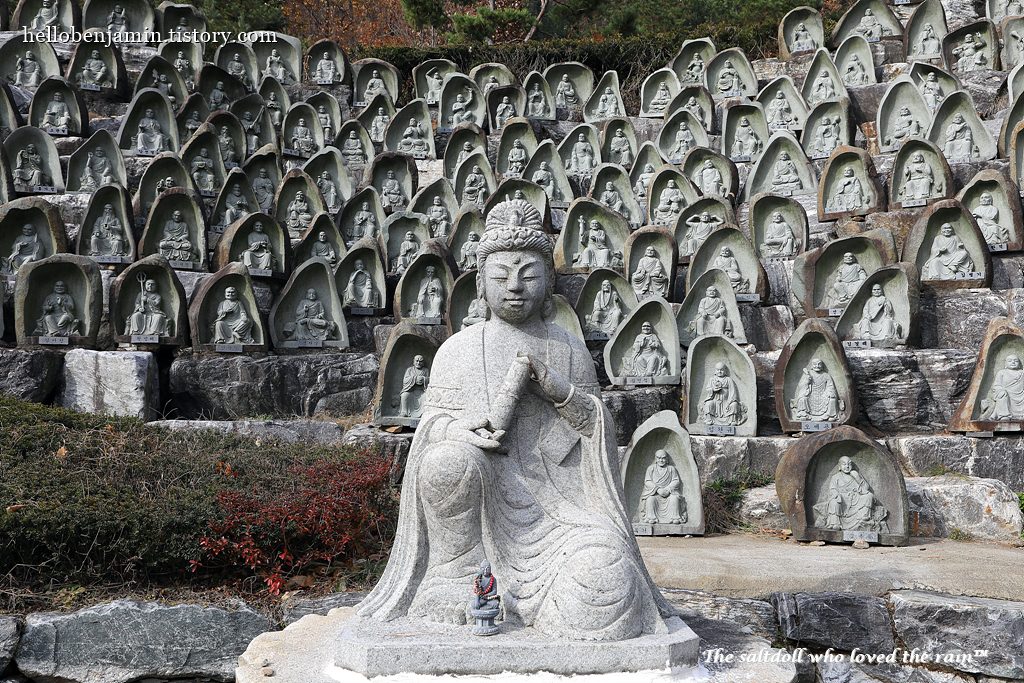

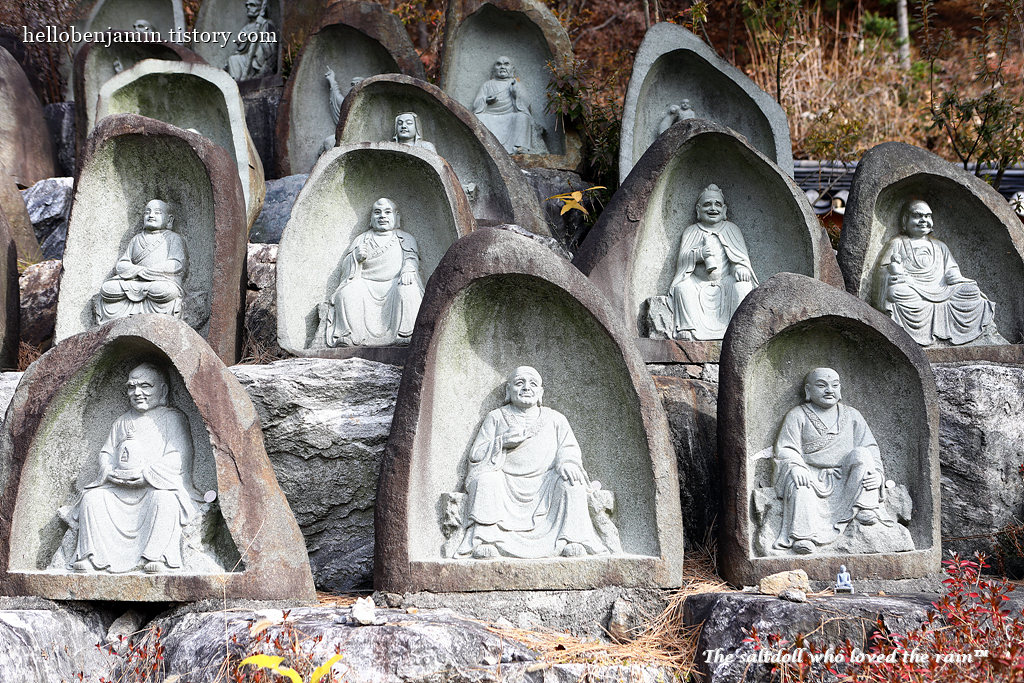
[500명의 나한상 모두 생김새와 표정이 모두 다르다는 것을 알 수 있습니다.]
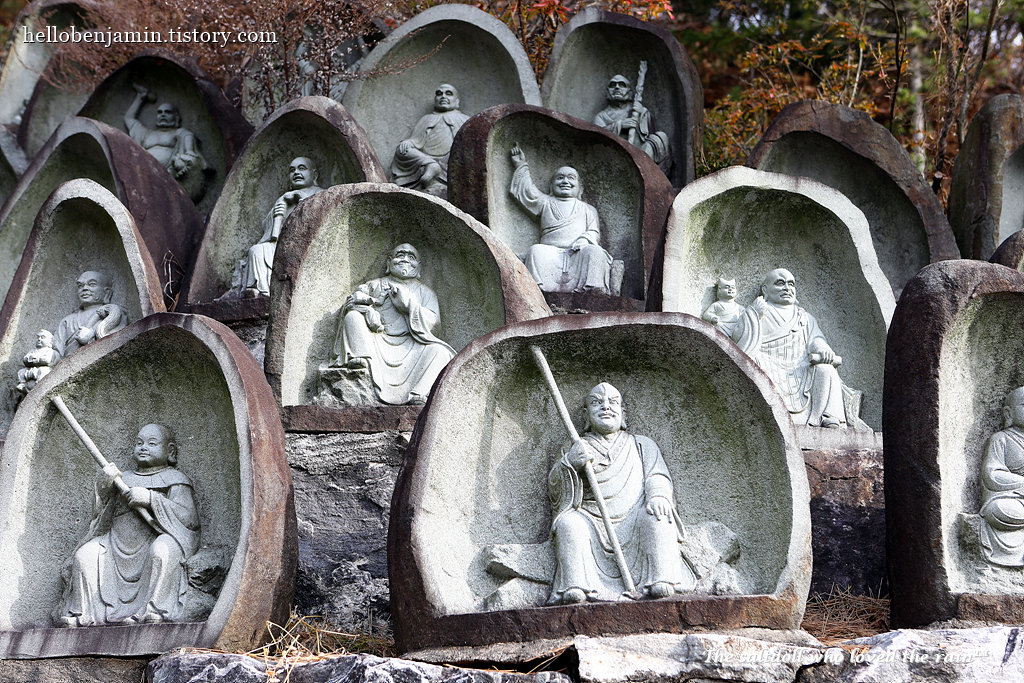




[미륵보살반가상은 국립중앙박물관에 소장되어 있는 금동 미륵반가상의 복제품입니다.]
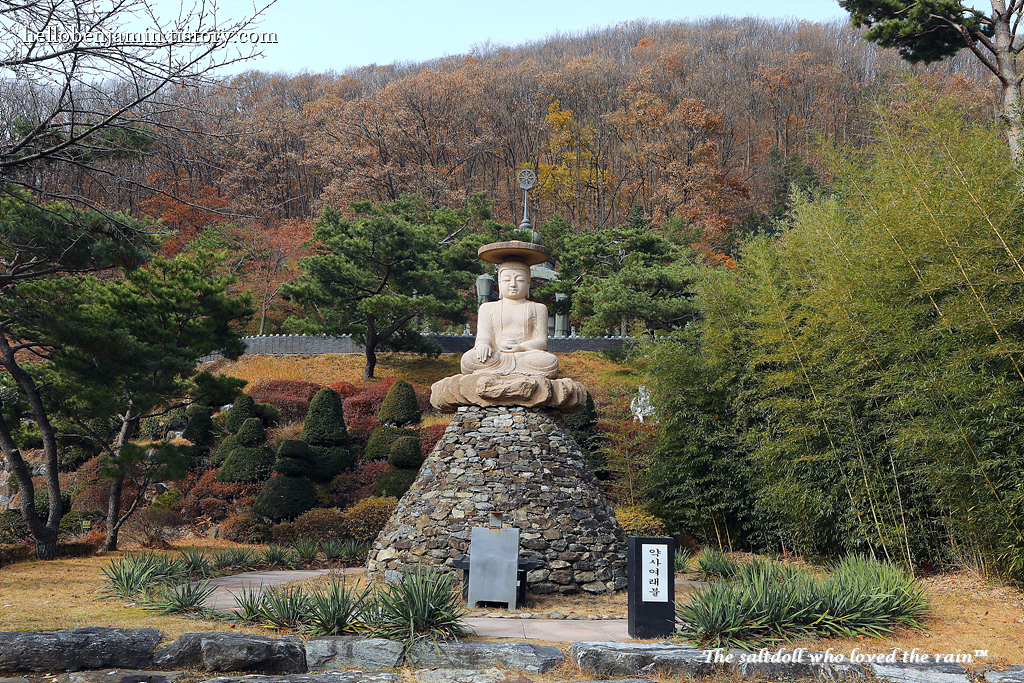
[약사여래상]
https://en.wikipedia.org/wiki/Bhaisajyaguru
Bhaisajyaguru - Wikipedia
From Wikipedia, the free encyclopedia Buddha of healing and medicine in Mahāyāna Buddhism This article is about the Medicine Buddha. For the Medicine King Bodhisattva, see Bhaishajyaraja. Bhaiṣajyaguru (Sanskrit: भैषज्यगुरु, Chinese
en.wikipedia.org
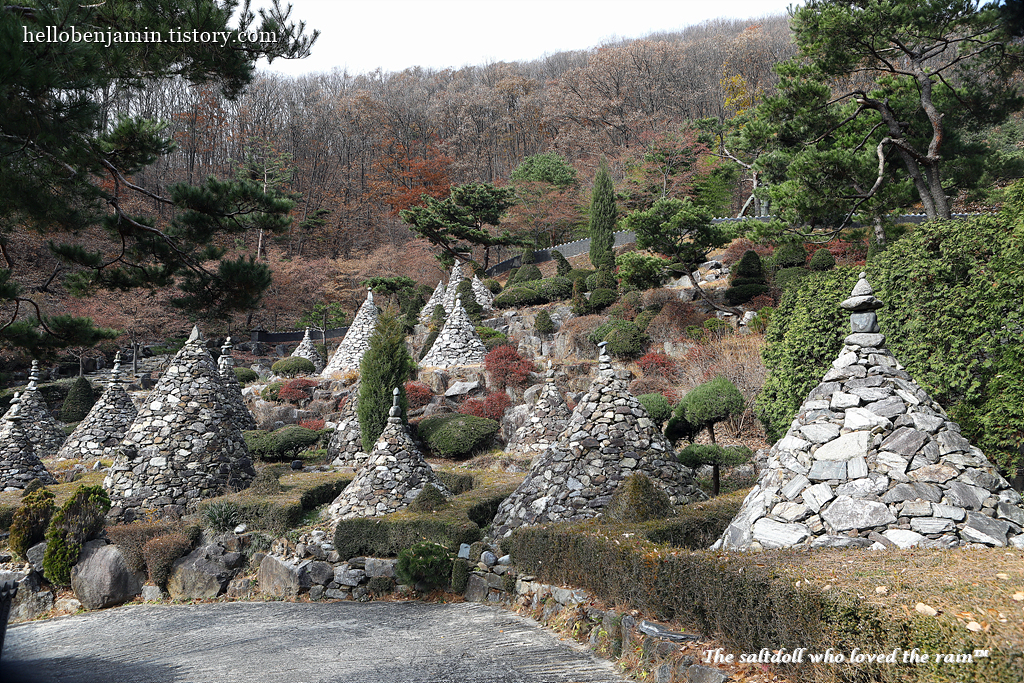
Earthly Branches
[십이지]
https://en.wikipedia.org/wiki/Earthly_Branches
Earthly Branches - Wikipedia
From Wikipedia, the free encyclopedia East Asian system of 12 ordinals The twelve Earthly Branches or Terrestrial Branches[1] are a Chinese ordering system used throughout East Asia in various contexts, including its ancient dating system, astrological tra
en.wikipedia.org
The year 2024 is the Year of the Dragon.
[2024년은 용의 해입니다.]
https://youtu.be/jZ7yG2Zs0xE?si=LevLHInCG5w4fRI9
This YouTube video is about the Zodiac or the twelve signs of the zodiac.
This YouTube video was made for children in Korea, but for fun, I thought it might be interesting for adults in other countries to watch as well.
Enabling the video's subtitles and setting them to your language will help you understand this story with relative accuracy.
If you're wondering what your zodiac animal is, get the following Excel file and run it.
Enter the current year, find your birthdate, and you'll see your zodiac animal on the right.
Refference : https://jban.co.kr/180
(엑셀첨부) 한국 나이 계산방법 세 가지 / How to count age in Korea
아래와 같이 우리나라에는 나이를 세는 세 가지 방법이 있습니다. 연령별 세 가지 나이를 쉽게 알아볼 수 있도록 엑셀파일도 첨부했으니 참고 부탁드립니다. '한국 나이' 방식은 출생 연도와 상
jban.co.kr
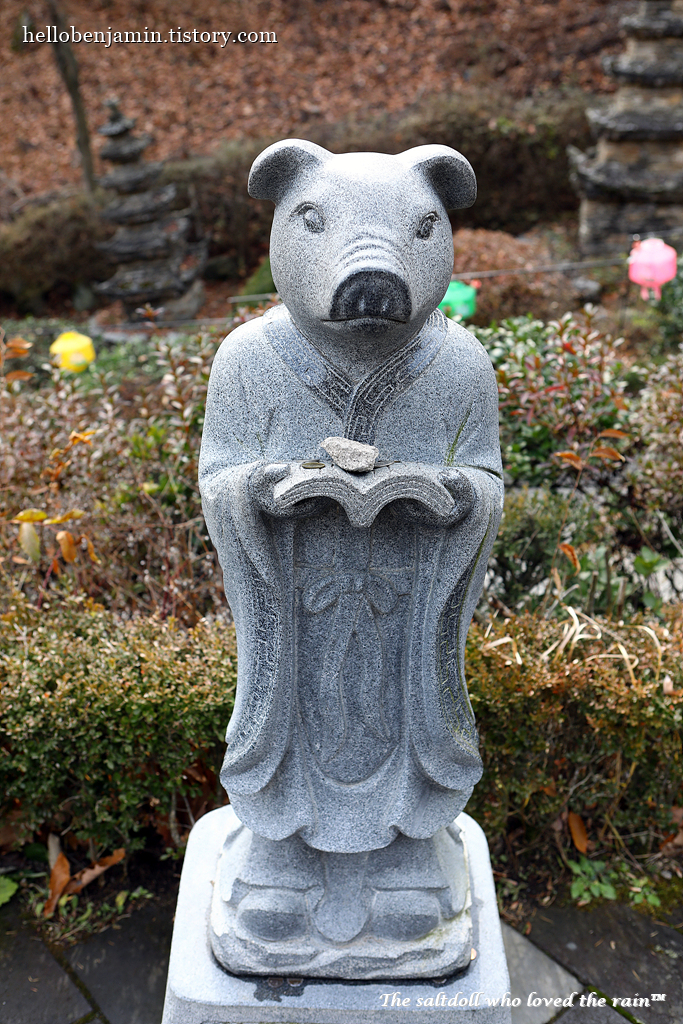
https://en.wikipedia.org/wiki/Pig_(zodiac)
Pig (zodiac) - Wikipedia
From Wikipedia, the free encyclopedia Sign of the Chinese zodiac Zodiac pig, showing the zhū (猪) character for pig Chinese paper cutting The Pig (豬) or sometimes translated as the Boar is the twelfth of the 12-year cycle of animals which appear in Chi
en.wikipedia.org

https://en.wikipedia.org/wiki/Dog_(zodiac)
Dog (zodiac) - Wikipedia
From Wikipedia, the free encyclopedia Sign of Chinese zodiac Zodiac dog, showing the gǒu (狗) character for dog Chinese paper cutting The Dog (狗) is eleventh of the 12-year cycle of animals which appear in the Chinese zodiac related to the Chinese cale
en.wikipedia.org
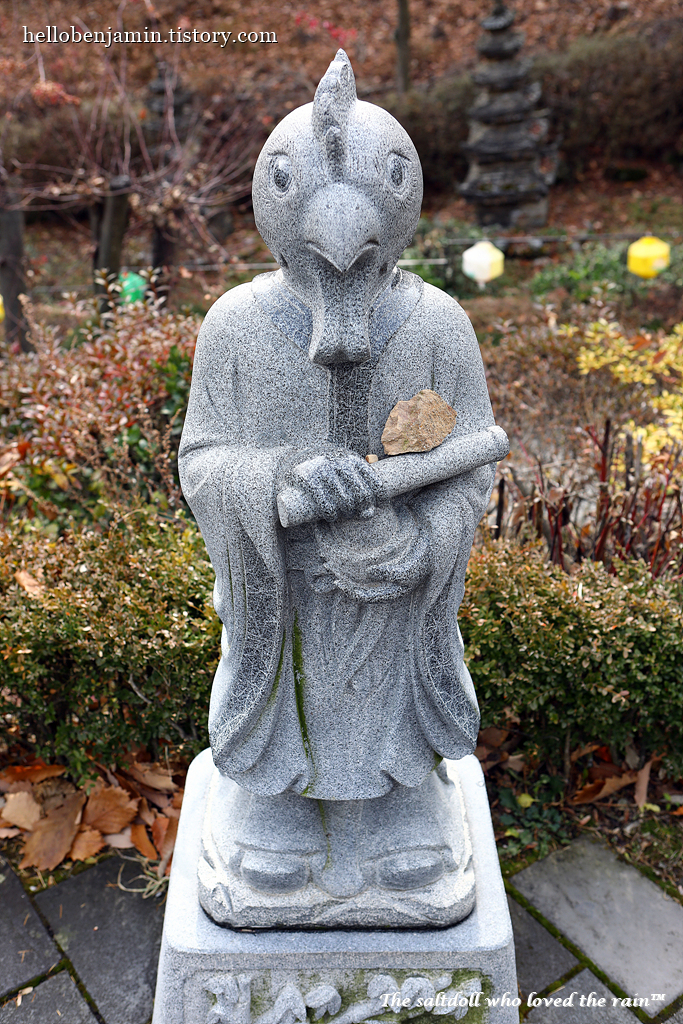
https://en.wikipedia.org/wiki/Rooster_(zodiac)
Rooster (zodiac) - Wikipedia
From Wikipedia, the free encyclopedia Sign of the Chinese zodiac Zodiac rooster, showing the jī (雞) character for rooster Chinese paper cutting The Rooster (simplified Chinese: 鸡; traditional Chinese: 雞/鷄) is the tenth of the 12-year cycle of anim
en.wikipedia.org
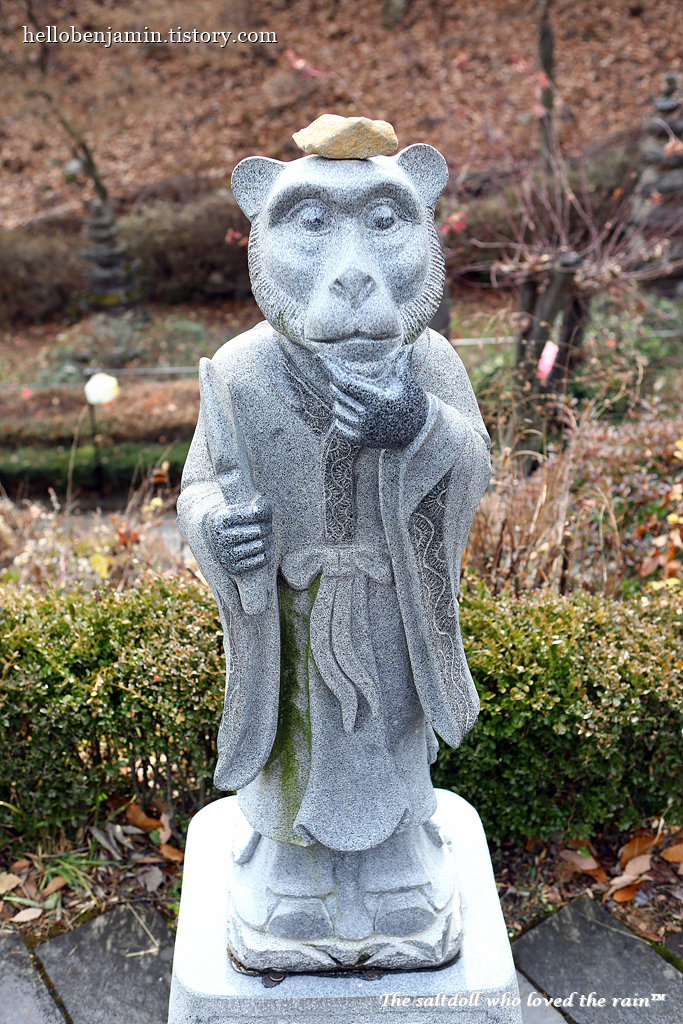
https://en.wikipedia.org/wiki/Monkey_(zodiac)
Monkey (zodiac) - Wikipedia
From Wikipedia, the free encyclopedia Sign of the Chinese zodiac Zodiac monkey, showing the hóu (猴) character for monkey The monkey (猴) is the ninth of the 12-year cycle of animals which appear in the Chinese zodiac related to the Chinese calendar. Th
en.wikipedia.org

https://en.wikipedia.org/wiki/Goat_(zodiac)
Goat (zodiac) - Wikipedia
From Wikipedia, the free encyclopedia Sign in the Chinese zodiac Zodiac goat, showing the yáng (羊) character for goat/sheep The Goat (Chinese: 羊; pinyin: yáng, sometimes also translated Sheep or Ram) is the eighth of the 12-year cycle of animals whic
en.wikipedia.org
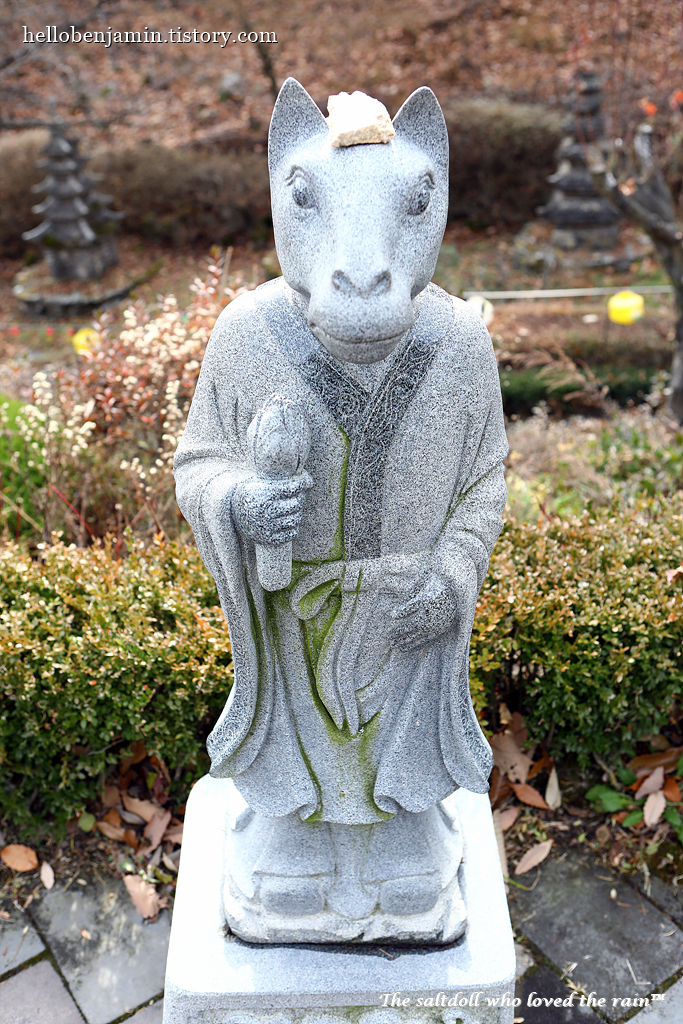
https://en.wikipedia.org/wiki/Horse_(zodiac)
Horse (zodiac) - Wikipedia
From Wikipedia, the free encyclopedia Sign of the Chinese zodiac Zodiac horse, showing the mǎ (⾺) character for horse The Horse (⾺) is the seventh of the 12-year cycle of animals which appear in the Chinese zodiac related to the Chinese calendar. Ther
en.wikipedia.org

https://en.wikipedia.org/wiki/Snake_(zodiac)
Snake (zodiac) - Wikipedia
From Wikipedia, the free encyclopedia Sign of the Chinese zodiac Zodiac snake, showing the shé (蛇) character for snake The snake (蛇) is the sixth of the twelve-year cycle of animals which appear in the Chinese zodiac related to the Chinese calendar. T
en.wikipedia.org

https://en.wikipedia.org/wiki/Dragon_(zodiac)
Dragon (zodiac) - Wikipedia
From Wikipedia, the free encyclopedia Chinese zodiac sign Zodiac dragon, showing the lóng (龍) character for dragon The dragon, also known as loong, (simplified Chinese: 龙; traditional Chinese: 龍; pinyin: lóng; Jyutping: lung4; Cantonese Yale: lùhn
en.wikipedia.org

https://en.wikipedia.org/wiki/Rabbit_(zodiac)
Rabbit (zodiac) - Wikipedia
From Wikipedia, the free encyclopedia Sign of the Chinese zodiac Zodiac Hare, showing the tù (兔) character for Hare The rabbit (兔) is the fourth in the twelve-year periodic sequence (cycle) of animals that appear in the Chinese zodiac related to the C
en.wikipedia.org
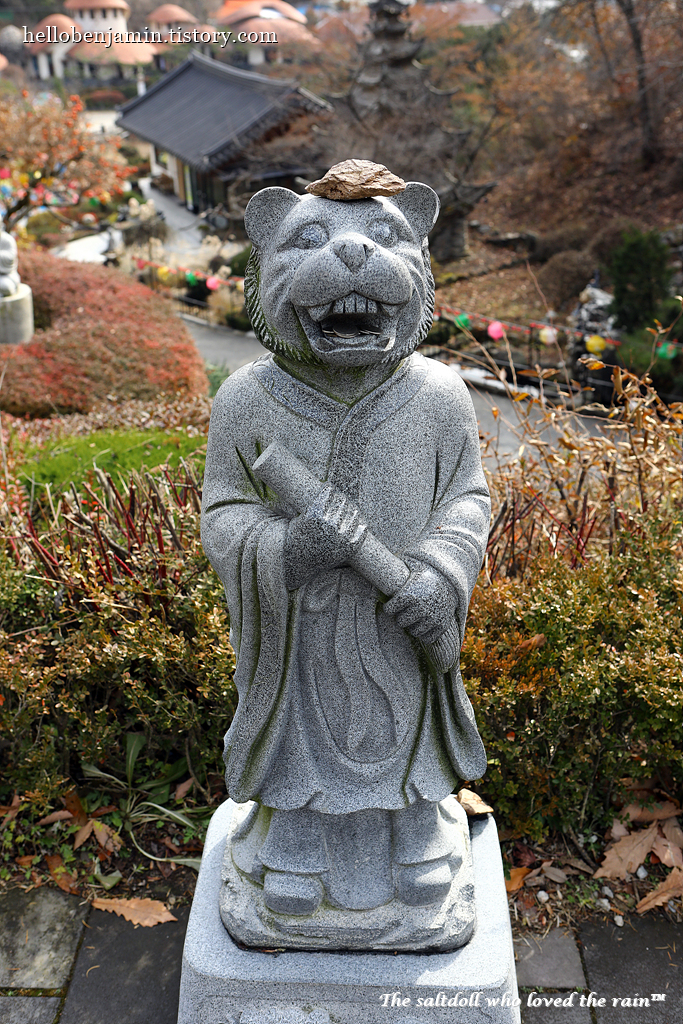
https://en.wikipedia.org/wiki/Tiger_(zodiac)
Tiger (zodiac) - Wikipedia
From Wikipedia, the free encyclopedia Sign of the Chinese zodiac Zodiac tiger, showing the hǔ (虎) character for tiger The Tiger (虎) is the third of the 12-year cycle of animals which appear in the Chinese zodiac related to the Chinese calendar. The Ye
en.wikipedia.org

https://en.wikipedia.org/wiki/Ox_(zodiac)
Ox (zodiac) - Wikipedia
From Wikipedia, the free encyclopedia Sign of the Chinese zodiac Zodiacal ox, showing the Chinese character niú (牛), meaning "ox" or "bovine creature". The same character is also used in some related languages. Carving of a bovine animal ("ox"), at Moun
en.wikipedia.org

https://en.wikipedia.org/wiki/Rat_(zodiac)
Rat (zodiac) - Wikipedia
From Wikipedia, the free encyclopedia Sign of the Chinese zodiac Zodiac rat, showing the shǔ (鼠) character for rat/mouse Stone monument with a carving of a mouse, at Mount Hôrai-ji Buddhist Temple, Aichi Prefecture, Japan, showing the zǐ (子) charact
en.wikipedia.org
Thank you for visiting my blog and reading the article.
- Camera : Canon EOS-5D Mark IV
- Lens : Canon EF 24-70L / f2.8
'Under Sky of Name Called the Sun' 카테고리의 다른 글
| Spring in the Hongneung Experimental Forest (홍릉숲의 봄) (0) | 2024.05.16 |
|---|---|
| Samcheong-dong (삼청동) (0) | 2024.05.12 |
| Hanok flavor (한옥의 정취) (0) | 2024.05.10 |
| 이화동 소경 (Ihwa-dong's blind spot) (0) | 2022.09.28 |
| 삼일절 삼청동 소경 (The blindsight of Samcheong-dong on March 1st Movement) (0) | 2022.09.28 |